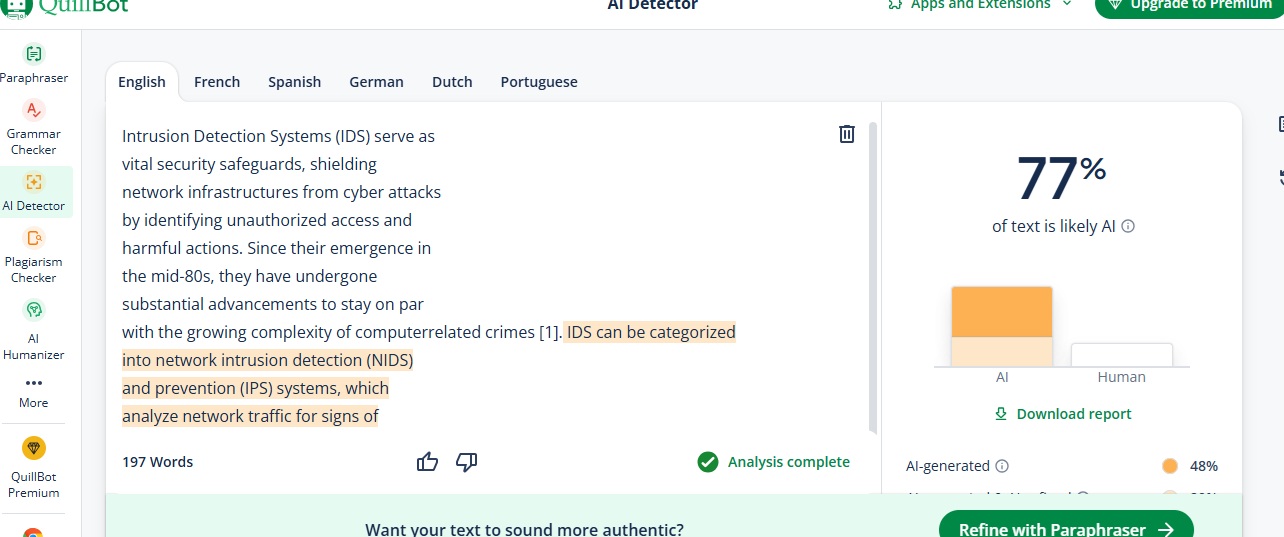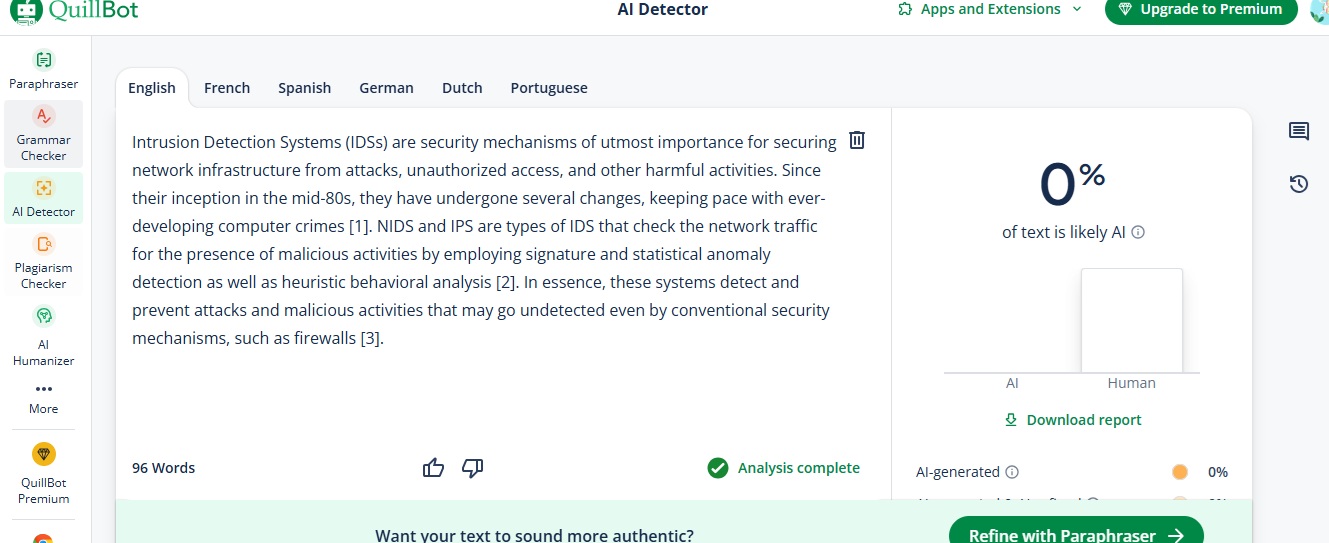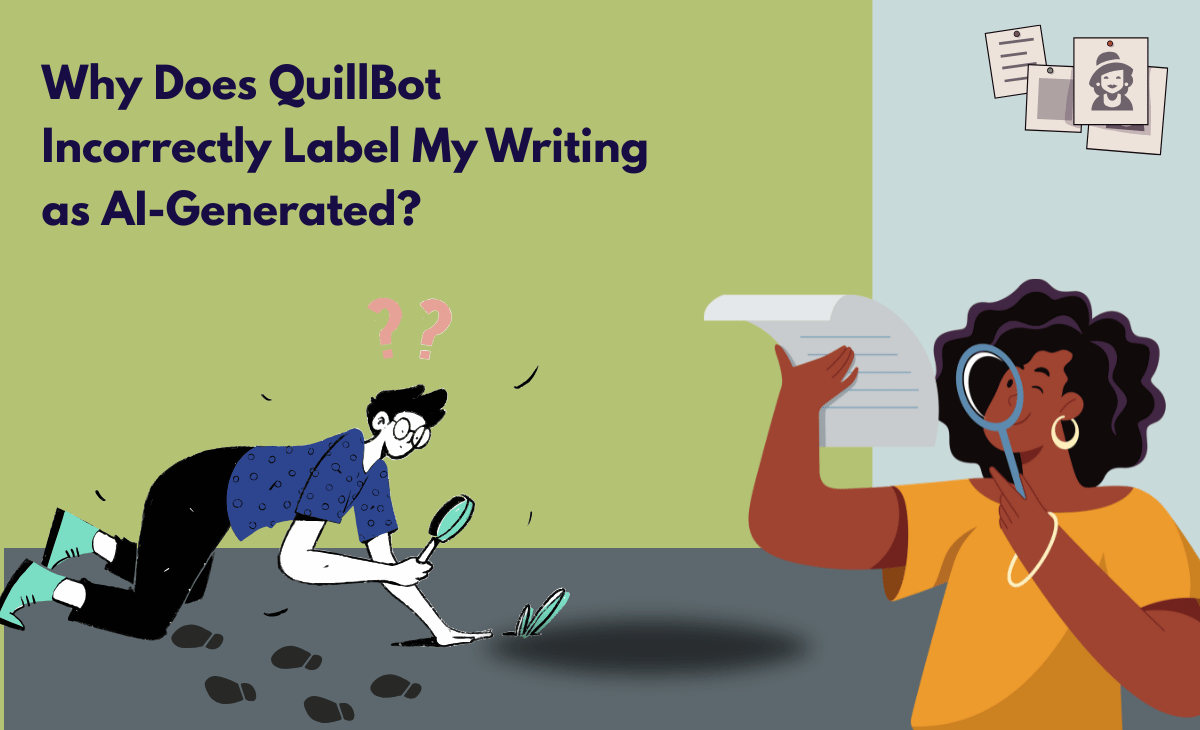Over time, QuillBot has become a household name, offering multiple solutions and ease of access in one bundle. However, as things become more intense with various AI writing tools flooding the market, QuillBot appears to falter significantly. It has reached a point where you will find everyone asking the same question: Why does QuillBot incorrectly label my writing as AI-generated? It has given rise to a panic-like situation.
This makes it difficult for writers, researchers, and especially people involved in academia to present their work without being anxious. They have to be mindful of every word and phrase they use, as we still have setups where using AI can lead to penalties and even termination of the entire work.
So, it is necessary to find a way around this problem and make sure nobody’s months of hard work lose their credibility with just one click. But before that, let us understand what QuillBot as a setup looks like.
What Is QuillBot's AI Detection Tool?
QuillBot is a multi-faceted tool that offers a lot of things in one place. You can write with Quillbot, paraphrase, and so on. However, its AI detector is the one that’s creating a stir now and needs to be looked at. QuillBot promises an advanced AI detection tool that categorizes your writing based on four categories:
- AI-generated
- AI-generated & AI-refined
- Human-written & AI-refined
- Human-written
It is almost like any other AI detector available in the market, given the functions it offers. But it makes its mark with different outcomes for the given text. Moreover, working with QuillBot is easy: all you need to do is copy and paste your text for it to detect the presence of AI.
But unlike popular detectors, QuillBot doesn’t rely on Perplexity or Burstiness, or the linguistic predictability of your content. It focuses more on looking at surface-level structure, tone, sentence uniformity, passive voice, and vocabulary patterns.
🚨Alert: But before we dive into it, here is a quick example of what’s wrong with idolizing QuillBot as an AI detector. I had taken an excerpt from the paper: A Review of Enhancing Intrusion Detection Systems for Cybersecurity Using Artificial Intelligence (AI) to understand how Quillbot reacts to it:

As you see here, QuillBot failed to identify that this piece is a collaborative human effort by Michal Markevych and Maurice Dawson. Now, this is where the confusion and panic usually set in. It makes the users wonder how safe it is to rely on QuillBot, especially in an academic setting where someone's career and entire life are dependent on this.
How Does QuillBot Work?
The reason QuillBot couldn’t identify this piece as human-written content is simple. The paper broke the pattern of how QuillBot looks at things. The tone of the writing here is strictly formal, with next to no visual imagery, and has a very diminished intention of connecting with its readers. All these are a quick giveaway for QuillBot to flag this as something machine-generated.
However, the reason behind this is just the basic principle of how a tool like QuillBot is designed to operate. It doesn’t know what an academic paper or a marketing copy is. All it knows are patterns and structures.
Quick Fact: QuillBot is known to rely on structural cues like sentence patterns, passive voice, repetitive phrasing, and so on. That’s precisely why the human-written paper above likely triggered a false flag. Here’s what happened:
- Pattern Bias: Usually, tools like QuillBot are trained on thousands of AI-generated materials to understand what it needs to flag. It helps it to recognize how AI is supposed to write and what it needs to restrict. So if you write like any of the datasets it was trained on, it will trigger detection.
- Lack of Personal Voice: Most detectors struggle with objectivity. Meaning, if you write in a formal tone and only focus on highlighting the technicalities, you might be in trouble. It’s the same with QuillBot, too, as it doesn’t recognize the purpose of the writing but only analyzes the tone of your text.
- Jargon and Repetition: When you write for a specific forum, you have to maintain its guidelines. So, you will find yourself using a lot of “enhanced performance,” “framework implementation,” or “data optimization” in your texts to convey your point. But this is not something that will sit right with a detector like QuillBot, and it might flag you as AI.
- Sentence Uniformity: If you analyze my sentences in this blog, you will find that I have used a variety of sentences to keep this discussion going. But if I were to write about new research or a technical tool, I would have adopted more straightforward sentences. But QuillBot often mistakes the lack of rhythm and flow for robotic structure, and would have never considered the results as a deliberate writing choice.
What to Do If QuillBot Flags Your Human Writing
The first thing that you need to keep in mind if you are writing is flagged by QuillBot is not to panic. QuillBot’s inability to acknowledge that a human-written text can be stringent or formal is not a miss on your part. But having said that, a quick look into the available solutions is also going to ensure you handle the AI detection with grace and work your way around it.
Use Real-Life Examples or Sensory Detail
You have to sit with your paper and analyze the various ways in which you can add something personal to your given piece of writing. It can either be a real-life example or a descriptive sensory detail, like “using this tool will give you the comfort of wrapping your ideas in a warm blanket.” You can even write on a more personal level to highlight how it changed your workflow.
Break Repetitive Patterns
A blog with no variations is not only boring, but also leads to a detector to believe that it is AI-generated. So you have to work on combining your technical sentences with meaningful, punchy lines. The idea is to break out from the rigid rhythm of AI-generated writing. If you don’t, then you will be punished under the false flag of detection, especially if you are a SaaS writer or into academia.
Express Uncertainty
The one thing about AI-generated writing is that it is always firm and precise. You will never find AI to be second-guessing its texts or saying that it “might be so.” So when it comes to AI detection, using a bit of uncertainty can actually work in your favour. Lines like “I’m still figuring this out myself” or “This may not work for everyone, but it worked for me” will help you see through the detector better.
Build a connection with your readers
AI-generated content doesn’t have the space to form a connection with the readers. It focuses more on delivering information than on starting a conversation. So it misses out on the genuine warmth and the intention to connect, which is also an obvious giveaway for the detectors.
But here is the catch:
| 🆘The thing is, even though these are tested ways to bypass detection, there’s a problem. In academic writing, you can’t just slip in a personal story. In SaaS blogs, you often have to stick to a formal tone and structure. That’s where traditional “marketing tricks” fall short. We have to think of a solution where you don’t have to put in much effort to scrutinize each sentence and also adhere to the decorum expected of each forum. |
How Humanize AI Solves This QuillBot Dilemma
This is where Humanize AI comes in to help you with this problem. It is frustrating to be marked down for machine-generated content, especially when you have put in all your hard work into it. It not only puts your credibility on the line, but also shakes your confidence as a writer.
You cannot ask ChatGPT to do it for you, as it will take away your original tone and voice and make you sound like every other writer out there. You just need the perfect balance of fine-tuning that gets rid of the obvious residue.
Firstly, using HumanizeAI.io is easy, as all it takes is a quick copy and paste, and that’s it. But more importantly, Humanize AI understands that humanizing content isn't just about breaking up rigid sentence patterns or sprinkling in “relatable” phrases. It’s about preserving the intention behind your words and yet helping you pass detection.
Remember that paper we talked about earlier in this blog that was flagged by QuillBot even though it was human-written? Well, it declared the same paper as 100% human-written after a few modifications with Humanize AI.


✅The reason Humanized AI worked here because it doesn’t just swap out words or alter sentence structures blindly. It took the text and refined its flow but made sure the substance was intact.
To put it short, you don’t always have to rewrite your entire work to bypass detection; sometimes, all it needs is a smarter tool.
Conclusion: Stay Human, Even When the Tools Don’t See It
Does getting flagged by Quillbot mean you are no longer a credible writer? Or does your research have less value to offer? Well, thankfully, it is never really so. All QuillBot does is identify words and patterns, and is in no way an apt indicator of how you should write. It just gives an easy upper hand to forums and institutions that don’t prefer the use of AI-generated text, considering the sensitivity of the given platform.
You must remember that: Being falsely labelled by an AI detector is in no way an insult to your intelligence, effort, or originality. It simply points out the limitations of the current tools we rely on.
At the same time, it doesn’t hurt to have a little help. Tools like Humanize AI aren’t here to rewrite your thoughts but to help you maintain the required dignity and safety checks of a given platform. By refining tone, varying structure, and preserving meaning, Humanize AI ensures your writing sounds unmistakably human. However, at the same time, it helps you keep your original voice intact, too.

